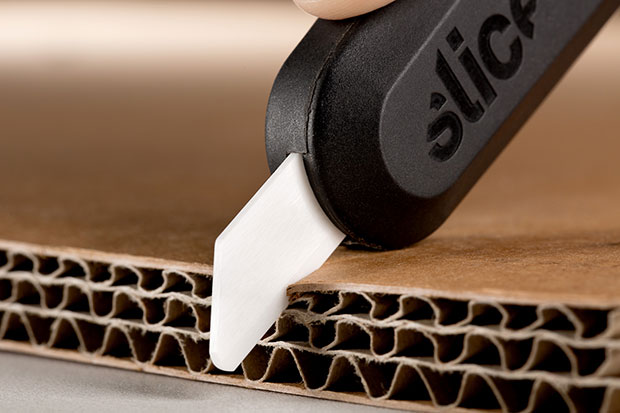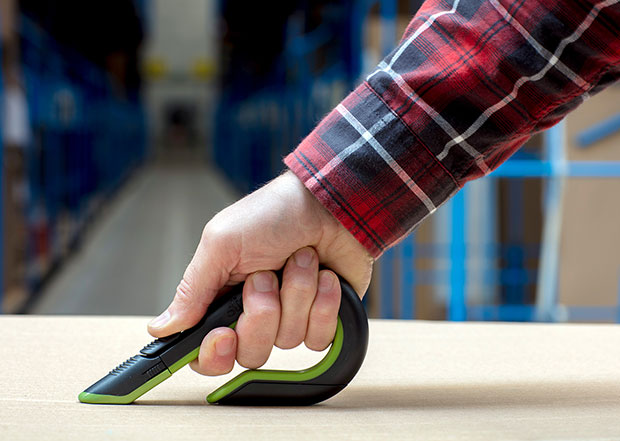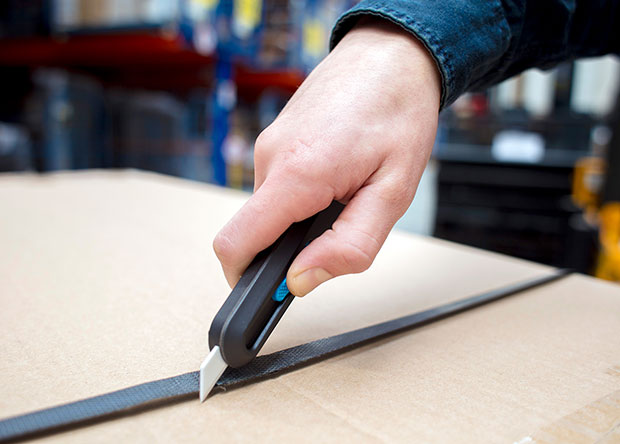Safety is a primary concern in the workplace, especially when it comes to cutting tools. Rightfully so. Lacerations are one of the most common workplace injuries, and cutting tools are largely the culprit.
In response, many manufacturers of industrial cutting tools have worked toward creating safety knives. However, their focus has been on handle design, and it’s not the handle that causes lacerations and punctures: it’s the blade.
Slice® is the only cutting tool manufacturer to create a truly safer blade. The Slice ceramic blade is finger-friendly®; it’s safe to the touch. Additionally, working with world-class designers, Slice has developed unique handles and safety features, always looking at design with fresh eyes and ergonomic innovations.
Slice Blades: Safety You Can Touch
Slice blades are made of industrial ceramic—100 percent zirconium oxide, to be specific. The material has become popular for making blades used in home and industrial cutting tools. Unfortunately, all ceramic-bladed tools tend to be mistakenly lumped together, as if they all share the same characteristics.
Ceramic blades are not all equal. There is a lot of misinformation out there.
Slice stands apart because of its proprietary blade grind, which makes the edge resistant to cutting through skin. This is featured on every blade Slice makes, from its box cutter blades and micro-ceramic blades, to its utility knife blades. To repeat, Slice is the only manufacturer to create a finger-friendly blade. It’s safety you can touch. Slice blades are also thicker, for extra durability.
The Slice blade features many other benefits inherent in advanced industrial ceramics. They are harder than steel. The Slice blade lasts up to 11 times longer than its metal counterparts. This means greater value and fewer blade changes; the latter results in greater safety—if you’re using a Slice blade—as blade changes are a prime time for laceration danger.

In addition to being safer and more durable, Slice ceramic blades have the following features:
- Non-magnetic
- Anti-static
- Non-conductive
- Non-sparking
- Safe up to 1600 degrees Celsius
- Chemically inert and non-contaminating
- Non-reactive: impervious to acids and salt
- Non-porous and chemically resistant
- Oil and lubricant free
- Never rust
Slice Addressed the Blade; Now On To the Handle
Slice agrees that handle improvements contribute to safety in two primary ways: ergonomics and blade retraction. Slice has made innovations to both.
Ergonomics are important because the more naturally a cutter fits in the hand and the easier the movement is, the less hand and forearm strain the user will experience. This reduces the chances of repetitive strain injuries.
Such injuries are common in industrial workplace settings. Slice has created several unique products to address ergonomic concerns. For instance, the J-hook design of the Slice box cutters.

Many knife manufacturers offer blade-retracting handles for box cutters and utility knives, so that the blade can be safely housed in the handle when the tool is not in use. There are generally two types offered: manual retraction and auto-retraction. As the name implies, the former requires the user to manually depress and move a slider to expose and retract the blade.
The latter requires the user to keep the slider engaged during use. When the slider is not actively engaged, the blade automatically retracts. This ensures, for instance, that if the tool gets dropped while in use, the blade will not remain exposed and pose a laceration threat.
Slice offers both options, and one more: we call it smart retracting. It’s the ultimate in safety. To keep the blade exposed the user must keep the button engaged, as with the auto-retracting tool. But also, there must be pressure on the blade. So the blade retracts if it loses contact with the material being cut—even if the slider is still engaged. Slice offers smart retraction on the 10558 Utility Knife.

Slice also considers handle material to address safety. Slice box cutter and utility knife handles are made of a glass-filled nylon, which is highly durable. The surface is easy to grip in order to reduce chances of slippage, so that you remain in control of your tool.
The Slice box cutter also keeps your products safe. As the name implies, this tool is commonly used to open boxes. However, traditional box cutters expose the blade a full inch, such that it can cut deeper than necessary. As a result, the product inside may get cut. Retailers and manufacturers lose millions of dollars in damaged goods every year due to such cuts.
The Slice box cutter only exposes the blade far enough to cut through single- and double-walled corrugated cardboard, keeping the products in the box from harm.
Is Slice Safer? The Proof is in Safety Success
Over half of the Fortune 1000 companies have come to Slice in their quest to improve workplace safety. Slice has also worked with several customers—including International Paper, Flowserve, TE Connectivity, NBCUniversal, Gillette, and Intertape Polymer Group (IPG), among others—who have tested our cutting tools in industrial settings and reported their results.
Their incidents of lacerations have decreased after switching to Slice. Flowserve clocked nearly a million work hours and counting without a time-loss incident, and International Paper credits Slice with being an important part of creating a strong safety culture.
TE Connectivity noted that Slice has reduced the chances of lacerations. Gillette eliminated lacerations where it switched to Slice tools, as did NBCUniversal, and IPG achieved its best safety record in three decades.
Are you ready to start your Slice safety success story?